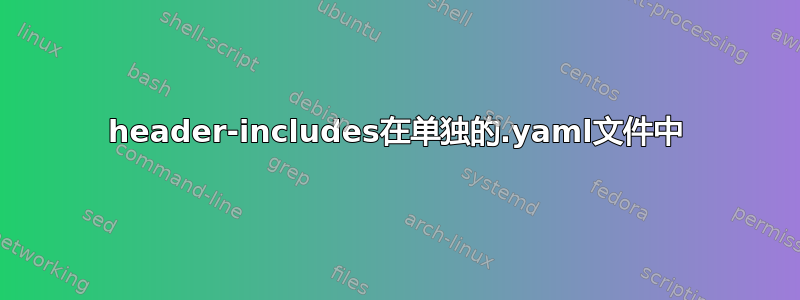
Pandoc 在生成 PDF 时使用 Tex 作为中间步骤,所以我认为在 StackExchange 的 Tex 部分提出这个问题可能是个好地方。如果不是,请告诉我,我会删除它。
如何指定 Pandoc 从 Markdown 生成 PDF 时应使用特定的页眉和页脚?
目前,我使用以下命令从命令行创建我的文档:
pandoc -s -V geometry:margin=1in --number-sections -o doc.pdf doc.mkd
这给出了带有编号部分的漂亮结果。
我想做的是,在每页中添加页眉和页脚。我该怎么做?
这扩展机制例如pandoc_title_block可能持有钥匙,但如何使用它呢?
最后(作为奖励),是否有办法使用 pandoc 为文档创建标题页?
答案1
和pandoc 1.12.x而且是新的YAML 元数据功能你可以在 markdown 文档中添加所需的所有信息和所有 LaTeX 代码,如下所示:
---
title: Test
author: Author Name
header-includes: |
\usepackage{fancyhdr}
\pagestyle{fancy}
\fancyhead[CO,CE]{This is fancy}
\fancyfoot[CO,CE]{So is this}
\fancyfoot[LE,RO]{\thepage}
abstract: This is a pandoc test . . .
...
# This is a test
Lorem ipsum....
这样您就不必修改模板,只需调用pandoc doc.md -o doc.pdf就足够了。
如果您想要更多控制权,您可以像这样添加新的元数据:
---
title: Test
author: Author Name
header: This is fancy
footer: So is this
geometry: margin=1in
abstract: This is a pandoc test . . .
...
# This is a test
Lorem ipsum....
为了使其正常工作,您必须相应地修改模板(pandoc -D latex > template.latex):
% filename: template.latex
\documentclass[$if(fontsize)$$fontsize$,$endif$$if(lang)$$lang$,$endif$$if(papersize)$$papersize$,$endif$$for(classoption)$$classoption$$sep$,$endfor$]{$documentclass$}
\usepackage[T1]{fontenc}
% -----------------------
% Using abstracts
\usepackage{abstract}
% -----------------------
% Using fancy headers and footers
\usepackage{fancyhdr}
\pagestyle{fancy}
\fancyhead[CO,CE]{$header$}
\fancyfoot[CO,CE]{$footer$}
\fancyfoot[LE,RO]{\thepage}
\usepackage{lmodern}
\usepackage{amssymb,amsmath}
\usepackage{ifxetex,ifluatex}
\usepackage{fixltx2e} % provides \textsubscript
% use upquote if available, for straight quotes in verbatim environments
\IfFileExists{upquote.sty}{\usepackage{upquote}}{}
\ifnum 0\ifxetex 1\fi\ifluatex 1\fi=0 % if pdftex
\usepackage[utf8]{inputenc}
$if(euro)$
\usepackage{eurosym}
$endif$
\else % if luatex or xelatex
\ifxetex
\usepackage{mathspec}
\usepackage{xltxtra,xunicode}
\else
\usepackage{fontspec}
\fi
\defaultfontfeatures{Mapping=tex-text,Scale=MatchLowercase}
\newcommand{\euro}{€}
$if(mainfont)$
\setmainfont{$mainfont$}
$endif$
$if(sansfont)$
\setsansfont{$sansfont$}
$endif$
$if(monofont)$
\setmonofont[Mapping=tex-ansi]{$monofont$}
$endif$
$if(mathfont)$
\setmathfont(Digits,Latin,Greek){$mathfont$}
$endif$
\fi
% use microtype if available
\IfFileExists{microtype.sty}{\usepackage{microtype}}{}
$if(geometry)$
\usepackage[$for(geometry)$$geometry$$sep$,$endfor$]{geometry}
$endif$
$if(natbib)$
\usepackage{natbib}
\bibliographystyle{$if(biblio-style)$$biblio-style$$else$plainnat$endif$}
$endif$
$if(biblatex)$
\usepackage{biblatex}
$if(biblio-files)$
\bibliography{$biblio-files$}
$endif$
$endif$
$if(listings)$
\usepackage{listings}
$endif$
$if(lhs)$
\lstnewenvironment{code}{\lstset{language=Haskell,basicstyle=\small\ttfamily}}{}
$endif$
$if(highlighting-macros)$
$highlighting-macros$
$endif$
$if(verbatim-in-note)$
\usepackage{fancyvrb}
$endif$
$if(tables)$
\usepackage{longtable}
$endif$
$if(graphics)$
\usepackage{graphicx}
% Redefine \includegraphics so that, unless explicit options are
% given, the image width will not exceed the width of the page.
% Images get their normal width if they fit onto the page, but
% are scaled down if they would overflow the margins.
\makeatletter
\def\ScaleIfNeeded{%
\ifdim\Gin@nat@width>\linewidth
\linewidth
\else
\Gin@nat@width
\fi
}
\makeatother
\let\Oldincludegraphics\includegraphics
{%
\catcode`\@=11\relax%
\gdef\includegraphics{\@ifnextchar[{\Oldincludegraphics}{\Oldincludegraphics[width=\ScaleIfNeeded]}}%
}%
$endif$
\ifxetex
\usepackage[setpagesize=false, % page size defined by xetex
unicode=false, % unicode breaks when used with xetex
xetex]{hyperref}
\else
\usepackage[unicode=true]{hyperref}
\fi
\hypersetup{breaklinks=true,
bookmarks=true,
pdfauthor={$author-meta$},
pdftitle={$title-meta$},
colorlinks=true,
citecolor=$if(citecolor)$$citecolor$$else$blue$endif$,
urlcolor=$if(urlcolor)$$urlcolor$$else$blue$endif$,
linkcolor=$if(linkcolor)$$linkcolor$$else$magenta$endif$,
pdfborder={0 0 0}}
\urlstyle{same} % don't use monospace font for urls
$if(links-as-notes)$
% Make links footnotes instead of hotlinks:
\renewcommand{\href}[2]{#2\footnote{\url{#1}}}
$endif$
$if(strikeout)$
\usepackage[normalem]{ulem}
% avoid problems with \sout in headers with hyperref:
\pdfstringdefDisableCommands{\renewcommand{\sout}{}}
$endif$
\setlength{\parindent}{0pt}
\setlength{\parskip}{6pt plus 2pt minus 1pt}
\setlength{\emergencystretch}{3em} % prevent overfull lines
$if(numbersections)$
\setcounter{secnumdepth}{5}
$else$
\setcounter{secnumdepth}{0}
$endif$
$if(verbatim-in-note)$
\VerbatimFootnotes % allows verbatim text in footnotes
$endif$
$if(lang)$
\ifxetex
\usepackage{polyglossia}
\setmainlanguage{$mainlang$}
\else
\usepackage[$lang$]{babel}
\fi
$endif$
$for(header-includes)$
$header-includes$
$endfor$
$if(title)$
\title{$title$}
$endif$
$if(subtitle)$
\subtitle{$subtitle$}
$endif$
\author{$for(author)$$author$$sep$ \and $endfor$}
\date{$date$}
\begin{document}
$if(title)$
\maketitle
$endif$
$for(include-before)$
$include-before$
$endfor$
$if(toc)$
{
\hypersetup{linkcolor=black}
\setcounter{tocdepth}{$toc-depth$}
\tableofcontents
}
$endif$
%-----------------------------------
% Adding the abstract
$if(abstract)$
\begin{abstract}
$abstract$
\end{abstract}
$endif$
$body$
$if(natbib)$
$if(biblio-files)$
$if(biblio-title)$
$if(book-class)$
\renewcommand\bibname{$biblio-title$}
$else$
\renewcommand\refname{$biblio-title$}
$endif$
$endif$
\bibliography{$biblio-files$}
$endif$
$endif$
$if(biblatex)$
\printbibliography$if(biblio-title)$[title=$biblio-title$]$endif$
$endif$
$for(include-after)$
$include-after$
$endfor$
\end{document}
这也是创建标题页的地方。如您所见,该模板只不过是一个带有一些 的 LaTeX 文档$variables$,因此应该很容易根据自己的喜好进行自定义。
现在只需使用模板选项调用 pandoc:
pandoc -s -N --template=template.latex doc.md -o doc.pdf
您可以在这里找到模板的文档:https://pandoc.org/MANUAL.html#templates
答案2
header-includes在单独的.yaml文件中
为了将格式与内容分离,人们可以简单地创建一个单独的header-includes.yaml文件:
---
header-includes: |
\newcommand{\j}{{\text{j}}}
\newcommand{\e}[1]{\,{\text{e}}^{#1}}
...
然后,运行pandoc(最好从makefile) 如下:
pandoc header-includes.yaml doc.md -o doc.pdf
这样做的好处是header-includes这样做的解释为 Pandoc Markdown,除非另有说明。当输出格式不同时,这很方便。例如,header-includes即使输出格式为 HTML,LaTeX 宏仍将继续对 LaTeX 数学产生影响。
pandoc header-includes.yaml doc.md -o doc.html
论点--include-in-header=FILENAME正如评论中其他地方所建议的那样,该
这种行为的另一个很好的例子是这里。



